This was published 11 years ago
One sweet mango
No stranger to catastrophe, Bangkok keeps bouncing back. Leisa Tyler explores the city's new hotels and places to eat, with a spot of shopping in between.
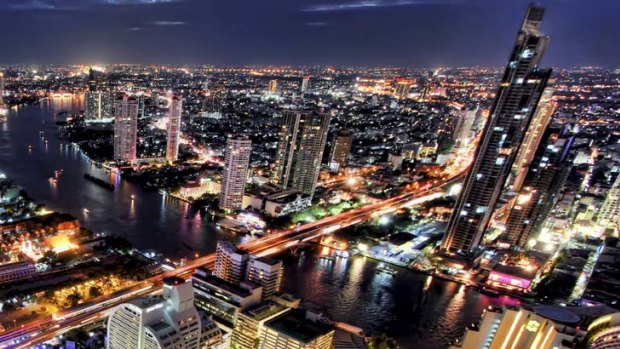
City of options ... the skyline of Bangok at night.Credit: Getty Images
Bangkok. City of Angels. The Big Mango. Sin City. Call it what you like, the Thai Kingdom's tempestuous capital is one of Asia's most beguiling and enticing cities. Established by the Thai royal family after the fall of Ayutthaya in the late 1700s, the city has undergone several incarnations from its humble beginnings as a small cluster of temples and palaces on the banks of the Chao Praya River.
The city's location, midway between India and China, quickly established its eminence as a trading post, but it wasn't until the influx of Chinese migrants in the early 20th century that changes in economics and multiculturalism ensued. The Vietnam War enforced the city's most infamous rebirth, as American soldiers looking to unwind and indulge away from the killing fields in the countries to the east inaugurated its illicit reputation.
In the four decades since, Bangkok has trebled in population to 14.5 million people and metamorphosed from a drowsy Asian backwater to an international city and thriving centre for art, fashion and design.
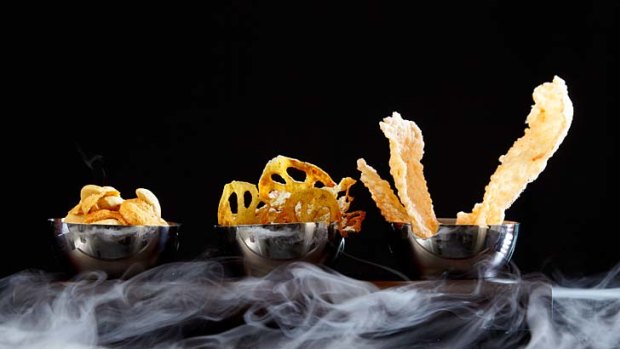
Eat in at Sra Bua by Kiin Kiin.
I first came to Bangkok in 1998, during the Asian financial crisis. The traffic was appalling and the pollution so bad it was said that if you stood on a main city intersection for an hour you would inhale more tar than in a packet of cigarettes. Thailand's once-tiger economy was devastated. Companies collapsed; the baht fell; construction works on highways and skyscrapers came to a screeching halt (most stayed that way for another 10 years).
I was based in Bangkok from 2000 to 2010. During this time the city transformed once again. The skies became cleaner, the tuk-tuks calmer, and with the opening of the excellent Skytrain and MRT metro lines, you no longer had to depend on the roads to get around. Nowadays, flyovers abound but the traffic is still horrible; last year I left a taxi, my luggage in the boot, in a traffic jam at Chidlom and went shopping for toothpaste. When I came back, fifteen minutes later, the taxi had moved five metres.
It's a city seemingly mired in perpetual crisis. In the past 10 years there has been an epidemic of SARS, several political coups, fierce rallies that barricaded the centre for more than a month, closing hotels and shopping malls, and then, at the end of last year, floods that washed down from the northern provinces, submerging half the city in crocodile-infested water. But no matter the tragedy, Bangkok bounces back.
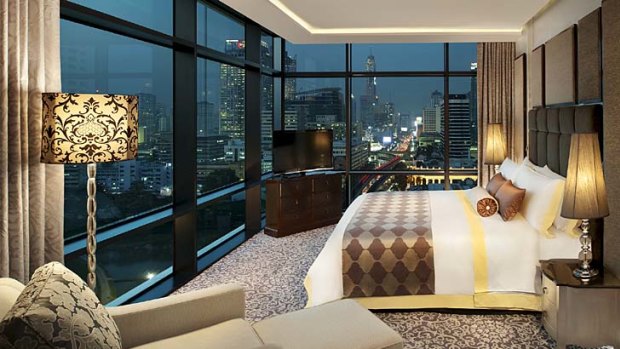
A suite at the St Regis.
"Bangkok has an incredible resilience," the general manager of the St Regis hotel, Holger Jakobs, tells me. "There is a catastrophe, tourists stop coming, and then a month later everything is back to normal."
That's good news for travellers. With a glut of hotel rooms driving room rates down, a string of cool new celeb-chef restaurants recently opening and a flourishing fashion scene, there has never been a better time to visit.
Sleep
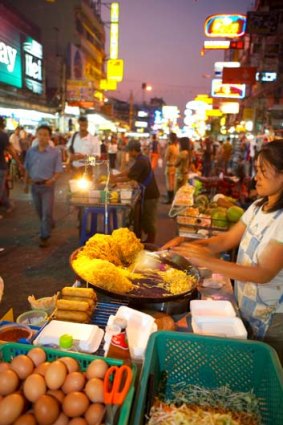
Hearty local cuisine is available at markets.Credit: Alamy
The most newsworthy hotel to swing open its doors in the past two years is the St Regis Bangkok (starwoodhotels.com; double rooms from 7600 baht - about $240). Bangkok has never been short of five-star lodges, but the appearance of Starwood's top echelon has now pushed the city's lodging scene onto a new level.
Occupying the upper floors of a tower on Rajadamri Road, with views over verdant Lumpini Park and the Royal Thai Sports Club - rare patches of green in this concrete jungle - the St Regis is elegant and refined. The 227 rooms have hardwood floors and paisley mauve carpets with cream and purple silk-covered furniture and big bath tubs; book a Caroline Astor Suite for space and views.
Come midyear, Bangkok's hotel standards will soar even higher. Flanking the edge of the Chao Praya River, The Siam (thesiamhotel.com; doubles from 19700 baht) promises a whole new level of sophistication. Designed by landscape gardener-cum-architect Bill Bensley, the boxy white and black property will have 39 generously sized guest rooms, each with towering ceilings, art deco features and Bangkok's highest rates to suit. The location is the downside: upstream from the old town, with no metro services nearby, guests will have to battle traffic to get anywhere.
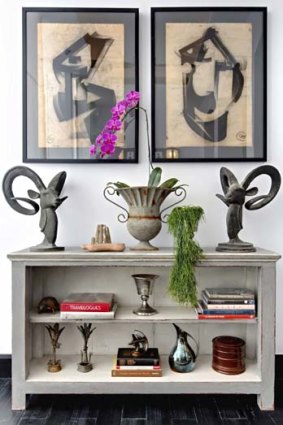
The decor in the Siam Hotel.
A stone's throw downstream from The Siam, Praya Palazzo (prayapalazzo.com; doubles from 5600 baht) opened in a 1923-built Italian-inspired mansion last year.
Seventeen rooms have reproduction furniture, bath tubs and walls painted in bright hues of orange and red. The superior rooms are a squeeze; book a deluxe for river views and small but private courtyards. The real reason to come here is for the peace: accessible only by boat (there is road access but staff are adamant you shouldn't use it), Praya Palazzo's gardens are a lovely patchwork of pathways and grass intercepted by thickets of lush tropical foliage, ponds wriggling with red fish and views over the busy river.
French management company Accor has been busy rolling out a series of budget-priced hotels in Bangkok. Last year alone the company saw the opening of two bargain-basement Ibis hotels, with rooms from about 1000 baht a night, and three Novotels. The Novotel Fenix Silom is a bargain with modish rooms, all with power showers and espresso machines, from 1813 baht; the 370-room Novotel Fenix Ploenchit is in a better location with rooms from 2824 baht. novotel.com.
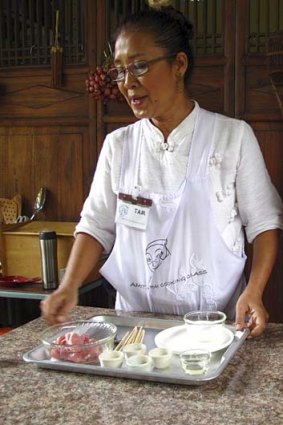
Tam Piyawadi Jantrupon at Amita Thai Cooking School.
Accor also opened Muse (hotelmusebangkok.com; doubles from 5510 baht) in late 2011, a 174-room tower on centrally located and upmarket Soi Langsuan, part of the company's M Gallery Collection. Themed on the glory days of travel in 1930s France, the hotel is dark and moody with cast-iron balustrades, wood panelling and paisley print walls; my only real whine being the miniscule gym and eight deck chairs at the pool for what could potentially be 350 guests.
Not to be outdone, Starwood has also been busy opening budget hotels. Its latest is Aloft Bangkok (alofthotels.com), a 296-room tower on the mildly boisterous bar street Sukhumvit Soi 11, which has the style of a W hotel but without the price tag.
Aimed at the young and plugged-in party crowd, rooms are functional and snazzy with free internet and coffee machines. Upgrade to a Touch Room and your room will come with a Samsung Galaxy smartphone that not only controls everything from room temperature to TV channels, but is equipped with a local SIM card that enables guests to be in touch, any time, anywhere.
Eat
Bangkok's best food is found at the dinky, sometimes even scruffy, hole-in-the-wall diners and food carts that line every other street. The best of these are in Pratunam or Chinatown. Little English is spoken but vendors are mostly congenial and patient and well versed in sign language.
If in doubt, book a tour with the food gurus from Bangkok Food Tours (bangkokfoodtours.com; tours from 750 baht), who lead small groups on heritage and cultural tours, stopping off to sample local delicacies along the way.
Beyond local eateries, a string of star-studded restaurants has opened in Bangkok over the past two years. In 2010 the only two-Michelin-starred restaurants in the world, then located in London and Copenhagen, opened satellite kitchens in the Thai capital within weeks of each other. First up was Sydney-born chef David Thompson with Nahm (metropolitan.bangkok.como.bz; dinner tasting menus from 3400 baht for two) at the Metropolitan Hotel.
Not for the faint-hearted, Thompson's zesty menu has old-time favourites such as fish liver curry and southern-style pork curry with longsart; some dishes haven't been seen in Bangkok for years. Refined and exquisitely executed, it's Bangkok's best, by far.
Close on Thompson's heels was Sra Bua by Kiin Kiin (kempinski.com; dinner tasting menus from 3600 baht for two), a satellite outpost of Thai interpretation restaurant Kiin Kiin, from Copenhagen.
Serving Thai food spun with molecular wizardry, Sra Bua was fun, eccentric and even a little bit zany when it first opened. The Thais hated it. A year and a half on, it's still left of centre, but with more spice and Thai accents. Order the degustation menu with dishes such as tom ka soup with satay ice-cream and crispy chicken skins and a gorgeous wonton soup with pickled pumpkin - a nod to the city's Chinese influences - and allow yourself to be entertained.
German-born British chef Rainer Becker's Zuma (159/99 Rachadamri Road; zumarestaurant.com; dinner is about 6000 baht for two) also made a splash when it opened in December 2011. Furnished with a dramatic stone wall and whole-tree-trunk benches overseeing an open kitchen, this is one of seven Zumas in the world, a chain that blends Japan's izakaya tradition with local flavours.
Suave and cutting-edge cool, like most Zumas, few people come here for the food, but rather to see and be seen.
Italian cuisine has been making headway as well. Guy Rossi from Melbourne's Grossi Florentino opened Grossi Trattoria (intercontinental.com; dinner from about 3500 baht for two) at the InterContinental Hotel last year. More hotel cafe than serious restaurant, Rossi excels at pasta - the pumpkin and ricotta ravioli and duck tortelloni are superb, as is the crab taglierini - but for anything else you'll be better off at JoJo's.
Set on the ground floor of the St Regis hotel, JoJo's (stregis.com; dinner from about 4000 baht for two) is a smart, 70-seat restaurant with extraordinary Protected Designation of Origin cold cuts and cheeses. Order an antipasti platter for culatello di Zibello, a smoky 46-month-cured prosciutto from the village of Zibello in Parma, and ciauscolo salame, an astoundingly good, spreadable salami from Macerata that has been smoked with juniper berries.
Shopping
No longer just a refuge for cheap rip-offs invented elsewhere, the Thais have been busy forging their own design and fashion identity.
Stylish design shops such as Propaganda and Anyroom can be found in the glitzy shopping malls and several Thai-language interior-design magazines line the news stands.
The fashion industry is booming. Home-grown clothes retailers are competing with big European labels and every year scores of hot new Thai designers make it to the catwalks of Paris and Milan. Bangkok even has its own annual fashion week.
For the best range of Thai fashion, head to Siam Centre. Built in 1973, this low-rise mall, sandwiched between heavyweights Paragon and the Discovery Centre, is home to a superb cluster of home-grown designers.
At the top of the pecking order are Japanese rock'n'roll-inspired Baking Soda, the clean-cut street wear threads from Greyhound, jazzy, fun women's wear at Flynow and the mid-bling leather accessories of Madam Tango .
Want more? The fresh-out-of-fashion-school and emerging designers display their threads in the hole-in-the-wall shops lining the lanes fanning away from Siam Square, or at Chatuchak Market.
History buff?
Bangkok has some of the world's oddest museums. The Corrections Museum (Maha Chai Road), in the old remand prison, displays the execution chamber and the corporal punishments once inflicted on inmates. Even more gory, the Siriraj Medical Museum (Siriraj Hospital, 2 Prannok Road), otherwise known as the museum of death, shows — with gut-wrenching detail — various terminal ailments, including a skull punctured with bullet holes and a haemorrhaged brain. A lot softer are the excellent exhibitions found at the Bangkok Art & Culture Centre (bacc.or.th) on Siam Square. Eleven years in the making, the 7600-square-metre non-profit space, designed by Robert Boughey, opened in early 2009 to give young artists a platform to display their creations.
Culinary detours ahead
An antidote to the clamour and speed of downtown Bangkok, if you need one, is a boat ride away at Amita Thai Cooking School (amitathaicooking.com, 3000 baht ($94) a person).
From yet another luxury city cocoon, the boutique MGallery VIE Hotel in Phaya Thai Road, Ratchathewi (viehotelbangkok.com, from about 3050 baht), we head for the Chao Phraya River and motor through its muddy-coloured waters, passing gritty scenes of daily life on the river.
Our destination, in Thonburi, is a pocket of tranquillity.
Tam Piyawadi Jantrupon, our cooking teacher, and her assistants greet us with cold towels, home-made lemongrass juice and snacks of tempura-battered tropical flowers. Tam conducts her classes in the family compound in which she was born and grew up, and whereshe continues to live with her extended family, on the banks of a canal flowing through old Bangkok.
Her grandmother lived to 97 in this compound, she tells us; her mother is 97 now. The extensive herb garden helps explain the longevity, Tam says; turmeric and butterfly pea protect from cancer, for example; hairy basil leaves act as a cleansing agent. Joined by pet chooks, we wander through the garden, picking and sniffing at kaffir lime, mint, spearmint, ginger, pennywort and basil.
The cooking class begins with Tam demonstrating the dishes we will then make ourselves. There are four dishes made in the half-day classes, including, in our case, green curry chicken, coconut rice and papaya salad and mango sticky rice.
Like many such schools, this is cooking for dummies — all the ingredients are prepared for you; all you have to do is cook them, with assistants standing by to ensure you can't even get that wrong. And then, of course, you get to eat the results.
Authentic food cooked in a local's home, not far from the city mayhem despite feeling a million miles away; this experience is worth tearing yourself away from the Michelin stars and skytop bars of modern Bangkok. Sarah Maguire
Trip notes
Getting there
Thai Airways and Qantas fly direct from Sydney to Bangkok daily. www.thaiairways.com, qantas.com.au.
When to go
There is no bad time to visit Bangkok. The weather is milder in November to February, the months Thais wishfully refer to as winter. March through to May is breathtakingly hot; June to October fraught with monsoonal downpours.
Top tip
Theoretically, it's illegal for taxi drivers in Bangkok not to use their meters. To save being fleeced by the unruly touts who hang around the hotels and main tourist areas, have your hotel write down your destinations, in Thai, and hail a taxi from the street.
Sign up for the Traveller Deals newsletter
Get exclusive travel deals delivered straight to your inbox. Sign up now.